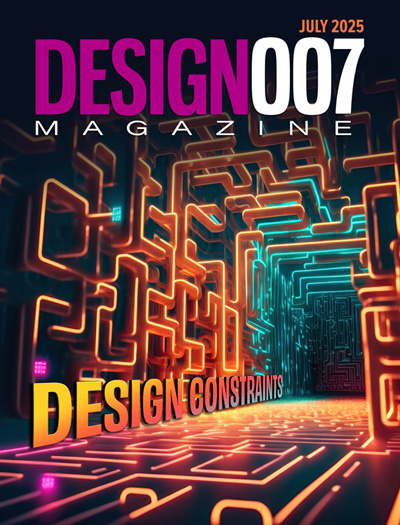-

- News
- Books
Featured Books
- design007 Magazine
Latest Issues
Current Issue
Signal Integrity
If you don’t have signal integrity problems now, you will eventually. This month, our expert contributors share a variety of SI techniques that can help designers avoid ground bounce, crosstalk, parasitic issues, and much more.

Proper Floor Planning
Floor planning decisions can make or break performance, manufacturability, and timelines. This month’s contributors weigh in with their best practices for proper floor planning and specific strategies to get it right.

Showing Some Constraint
A strong design constraint strategy carefully balances a wide range of electrical and manufacturing trade-offs. This month, we explore the key requirements, common challenges, and best practices behind building an effective constraint strategy.
- Articles
- Columns
- Links
- Media kit
||| MENU - design007 Magazine
RS Components Launches Professional Upgrade to Free PCB Design Tool in N.A.
October 31, 2019 | GlobeNewswireEstimated reading time: 1 minute
In conjunction with the official launch of its DesignSpark online engineering and design community in North America, RS Components (RS), a global multi-channel provider of industrial and electronic products and solutions, is debuting DesignSpark PCB Pro, a professional-level upgrade to its already popular free online PCB design tool, DesignSpark PCB.
DesignSpark PCB is an award-winning, free-to-use electronic computer-assisted design (ECAD) rapid prototyping tool offering workflow integration; unlimited schematic size, sheets, nodes, pads and connections; part library integration; unrestricted Gerber and ODB++ file output; multi-format bill of material generation; and compatibility with all other DesignSpark CAD systems.
In addition to the features available in the free tool, DesignSpark PCB Pro is specifically designed to bridge the gap between existing complex, high-cost, PCB design software and low-end, unsupported open-source tools for professional design engineers. The software provides an upgraded design suite, along with a wealth of productivity features to accelerate and enhance the design process, including blind and buried vias, extensive copper pour rules, hierarchical blocks, net class-level spacing rules, and manufacturability checks. An upgraded autorouter optimizes the efficiency of the board layout, while enhanced library support allows import of the latest symbols, footprints and 3D models. DesignSpark PCB Pro is now available for users in North America for just $449 for a perpetual license.
"With the addition of DesignSpark PCB Pro, RS Components is excited to add yet another cost-effective, easy-to-use professional tool to the resources available through our 850,000 member-strong DesignSpark online engineering community," said Cameron Ward, senior vice president of RS Components. "We remain committed to finding new ways to enable and partner with electronics designers, engineers and buyers across the entire product lifecycle."
Both DesignSpark PCB and DesignSpark PCB Pro are part of the suite of tools and resources available through DesignSpark, RS Components' free online engineering community that joins together more than 100,000 active members in North America, and more than 850,000 globally to solve companies' toughest engineering design challenges. The fast-growing platform, which added almost 130,000 worldwide users in 2019, provides resources, connections, tools and online purchasing for engineers throughout the product lifecycle.
Find out how RS Components can help make your technology vision a reality by joining the DesignSpark community, and by connecting with them on Twitter, LinkedIn, Facebook or Instagram.
Testimonial
"Our marketing partnership with I-Connect007 is already delivering. Just a day after our press release went live, we received a direct inquiry about our updated products!"
Rachael Temple - AlltematedSuggested Items
Trouble in Your Tank: Implementing Direct Metallization in Advanced Substrate Packaging
09/15/2025 | Michael Carano -- Column: Trouble in Your TankDirect metallization systems based on conductive graphite are gaining popularity throughout the world. The environmental and productivity gains achievable with this process are outstanding. Direct metallization reduces the costs of compliance, waste treatment, and legal issues related to chemical exposure. A graphite-based direct plate system has been devised to address these needs.
Closing the Loop on PCB Etching Waste
09/09/2025 | Shawn Stone, IECAs the PCB industry continues its push toward greener, more cost-efficient operations, Sigma Engineering’s Mecer System offers a comprehensive solution to two of the industry’s most persistent pain points: etchant consumption and rinse water waste. Designed as a modular, fully automated platform, the Mecer System regenerates spent copper etchants—both alkaline and acidic—and simultaneously recycles rinse water, transforming a traditionally linear chemical process into a closed-loop system.
Driving Innovation: Depth Routing Processes—Achieving Unparalleled Precision in Complex PCBs
09/08/2025 | Kurt Palmer -- Column: Driving InnovationIn PCB manufacturing, the demand for increasingly complex and miniaturized designs continually pushes the boundaries of traditional fabrication methods, including depth routing. Success in these applications demands not only on robust machinery but also sophisticated control functions. PCB manufacturers rely on advanced machine features and process methodologies to meet their precise depth routing goals. Here, I’ll explore some crucial functions that empower manufacturers to master complex depth routing challenges.
Trouble in Your Tank: Minimizing Small-via Defects for High-reliability PCBs
08/27/2025 | Michael Carano -- Column: Trouble in Your TankTo quote the comedian Stephen Wright, “If at first you don’t succeed, then skydiving is not for you.” That can be the battle cry when you find that only small-diameter vias are exhibiting voids. Why are small holes more prone to voids than larger vias when processed through electroless copper? There are several reasons.
The Government Circuit: Navigating New Trade Headwinds and New Partnerships
08/25/2025 | Chris Mitchell -- Column: The Government CircuitAs global trade winds continue to howl, the electronics manufacturing industry finds itself at a critical juncture. After months of warnings, the U.S. Government has implemented a broad array of tariff increases, with fresh duties hitting copper-based products, semiconductors, and imports from many nations. On the positive side, tentative trade agreements with Europe, China, Japan, and other nations are providing at least some clarity and counterbalance.


